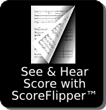And Give You Peace
| Composer | Naff, George |
|---|---|
| Duration | 7 |
| Ensemble | Concert Band |
| Genre | Modern Classical |
| Grade | 3 |
| Model Number | AOS1681 |
| Category | Concert Band - All Products, Grade 3, Original Compositions |
"For the last half-century I have sung this benediction with many choirs and have performed it with most of the choral groups I have conducted. When Mr. Joseph Cofer requested an instrumental adaptation of it, I was delighted but also a bit concerned because of the need for this instrumental adaptation to remain true to its choral roots – that it retain a lovely voice-like quality in keeping with Mr. Lutkin’s concept of pure tone and exceptional balance. Mr. Lutkin was a major influence for a cappella choral singing. (From his biography): While at Northwestern University, he founded, among other choral ensembles, the A Cappella Choir (1906), the first a cappella choir in the United States…Mr. Lutkin's Northwestern A Cappella Choir was widely recognized for its pure tone and exceptional balance.
Historical Information (from the Psalter Hymnal Handbook)
The words of The Lord Bless You and Keep You come entirely from Numbers 6:24-26 (RSV), well known as the priestly blessing and the Aaronic benediction. Benediction was composed in 1900 by Peter Christian Lutkin (1858-1931). This music is more an anthem than a hymn; it was called a "Farewell Anthem with Sevenfold Amen."
Orphaned at an early age, Peter C. Lutkin was raised in Chicago and had his early musical training in the choir school of the St. James Episcopal Cathedral. He studied under prominent organ teachers in Chicago, continued his education in Europe (1881-1884), and earned a doctorate in music from Syracuse University in 1900. In Chicago he served as organist and choirmaster at St. Clements Episcopal Church (1884-1891) and St. James Cathedral (1891-1896) and taught music theory at the American Conservatory (1885-1895). Lutkin was one of the founders of the American Guild of Organists. He also established the Chicago North Shore Festivals and founded the Northwestern University School of Music, of which he was the first dean (1896-1920). At several different times Lutkin was president of the Music Teacher's National Association. A composer of organ and choral music, he served on the editorial committees for both the Methodist Hymnal (1905) and the Episcopal Hymnal (1918).
A Word for the Conductor
As a work in the Making Music Beautiful Series, this piece has a dual purpose: aesthetic and educational. It is designed specifically as a tool to help student musicians develop the ability to play with a lovely sustained, characteristic tone that blends. A major challenge I face in my work as a band director, especially with younger players, is to achieve true sostenuto. A secondary pedagogical benefit for this piece is for the students to experience the beauty and expression of rubato playing/singing.
Lutkin’s lovely Benediction has been interpreted a number of ways over the last century. I suspect Mr. Lutkin would be happy for us to use our own interpretation as long as we maintain the attitude and the integrity of his music. I have arranged it with a good bit of rubato according to my own interpretation. To facilitate this for the conductor I have written it in 4/4 time, to allow for rubato nuances without having to subdivide the beat.
I have written a literal statement (though a step lower) of the Benediction, ms. 68-94, for low brass choir and have included optional choral parts in case the conductor may wish to use this piece with a chorus in a joint performance. If a chorus is used, it will be very important to balance this carefully with the brass so the voices predominate – (perhaps even to the point of having the chorus sing the section, from ms. 68-94, a cappella with the band joining them for the Seven-Fold Amen at m. 94.)
In this “literal” section at 68 you will notice the brass choir has French horn lead which provides a lovely, darker color for the ensemble, though the first horn part may be a bit challenging range-wise. Again, notice how this section is cued so you can “build” the brass choir in such a way to achieve your best sound. Comparing this with the SATB choir, the primary instruments for Soprano and Alto voices are Hrn 1 & 2. Primary instruments for the Tenor voices are Trb 1 & 2. Primary instrument for the Bass Voices is Euphonium which is cued in Trb 3. Tuba doubles euphonium in a few places down an octave.
The flute solo at m. 34 may be taken up an octave if necessary for it to project properly. Then the upper octave may continue when the rest of the flutes come in (ms. 38-41).
As the music “expands” from ms. 69 to 104 it will get louder naturally. It will be very important not to let the winds overpower the voices. Then from m. 105 to the end it "winds down" again getting slower and softer until finally it dies away with the sound of the chime.
This piece may be effectively used for closing a sacred music program or as a 'Benediction" for a worship service. If an abbreviated version with chorus is desired, begin the piece at m. 60.
My hope is that Mr. Lutkin’s Benediction will bless you, your performers, and all who hear it.
All the Best,
George Naff
Instrumentation:
- Flute 1-2
- Oboe
- Clarinet in B♭ 1-3
- Bass Clarinet in B♭
- Bassoon
- Alto Saxophone 1-2
- Tenor Saxophone
- Baritone Saxophone
- Trumpet in B♭ 1-3
- Horn 1 – 2
- Trombone 1-3
- Euphonium
- Tuba
- String Bass
- Timpani
- Cymbals (Crash and Suspended)
- Mallets (Chimes and Glock)
- Optional SATB Choir









